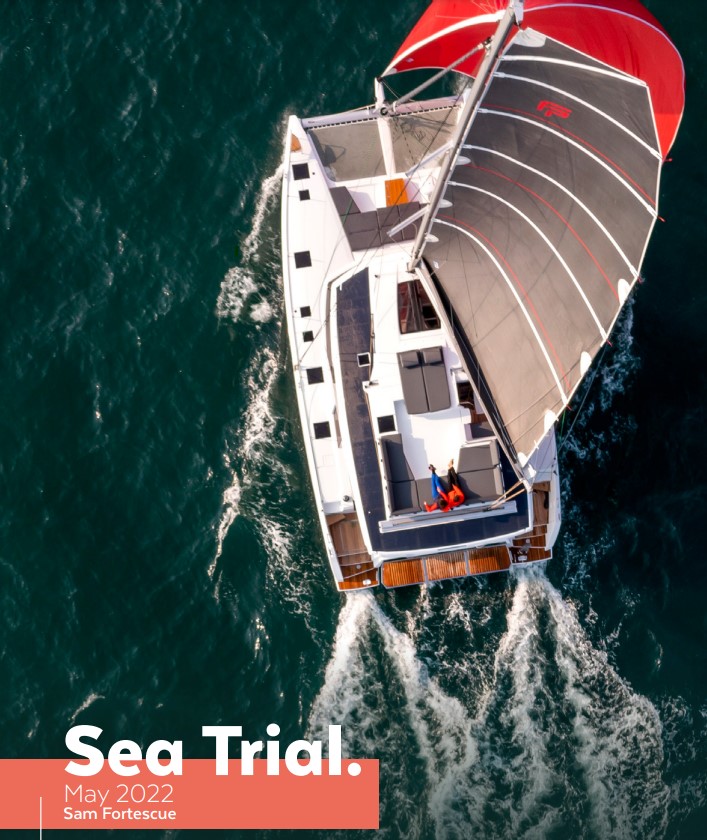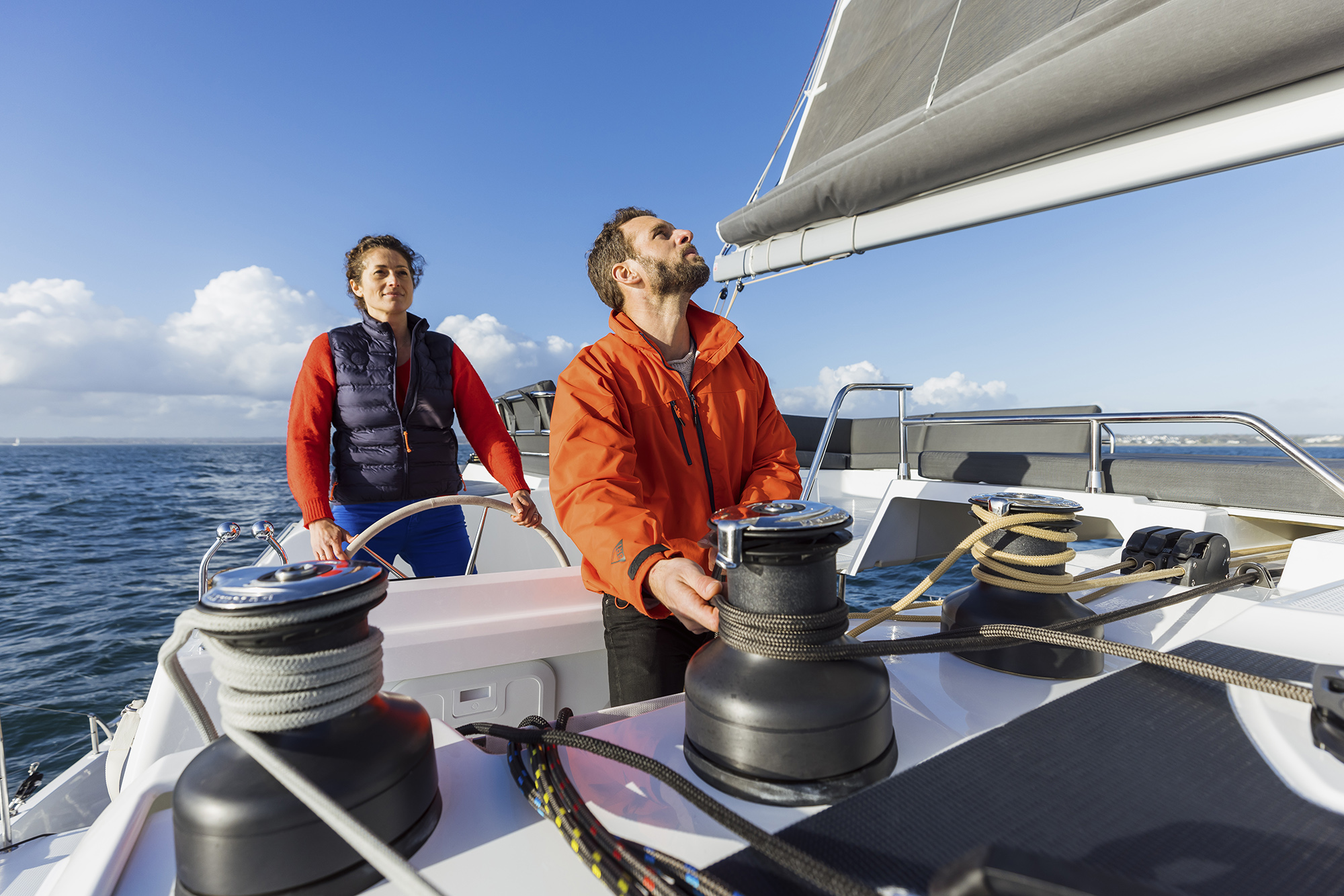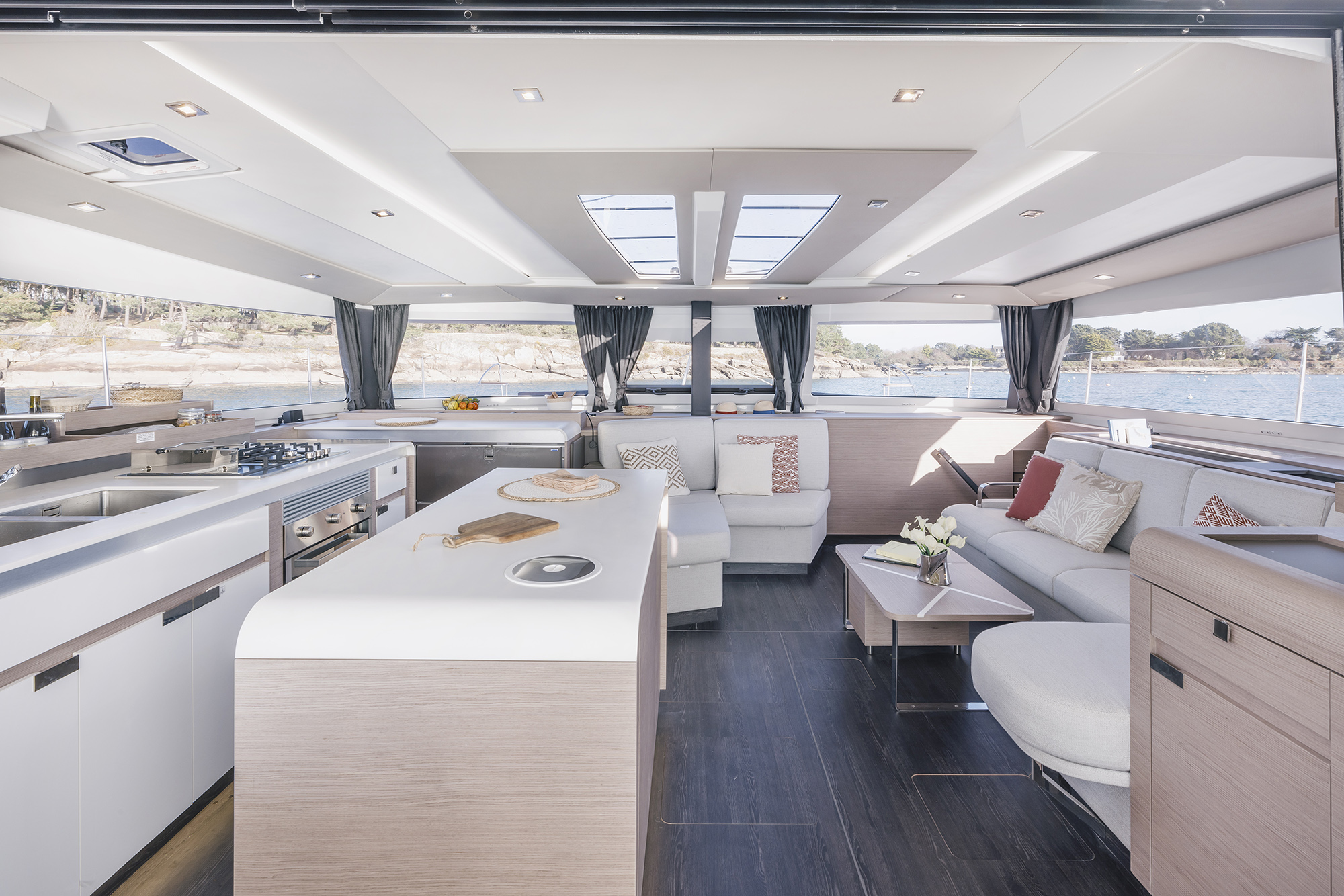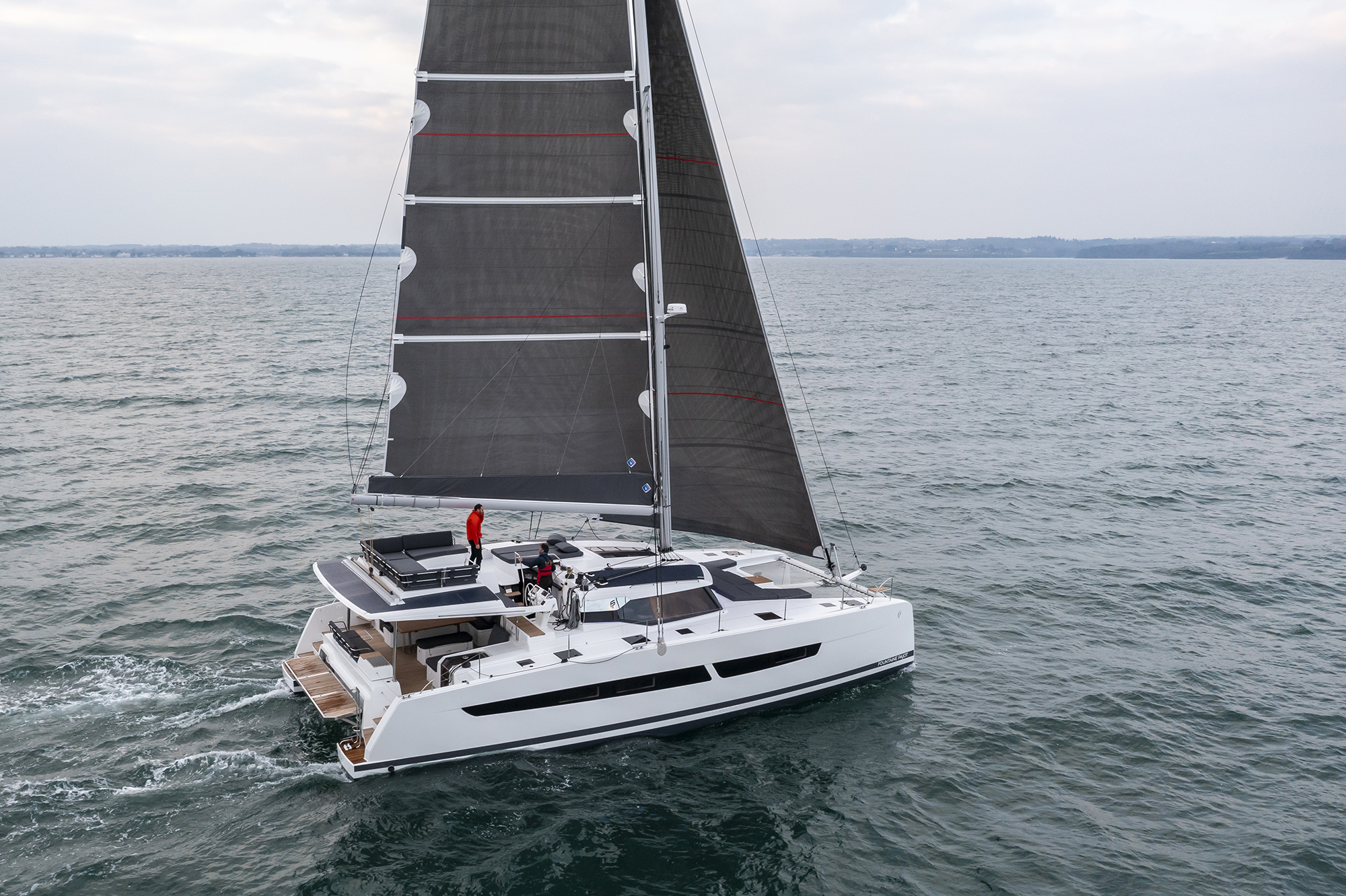Aura 51 review
AURA 51 SEA TRIAL REVIEW by Sam Fortescue, May 2022
Sam Fortescue meets Fountaine-Pajot’s latest cruising cat, blending comfort and sustainability
AURA 51 Full information and prices AURA 51 review - PDF magazine article

Place of the Sea Trial : La Rochelle, France
Journalist : Sam Fortescue
If you can sell over 150 catamarans off-plan before construction has even begun, you have the confidence of your owners. Fountaine-Pajot’s Aura 51 has achieved just that, and it is perhaps one of the most extraordinary marketing feats in modern boatbuilding.
So when the chance came to sneak an exclusive test-sail on the first hull to hit the water, I didn’t need convincing. After a gale-racked February, March at last brought sunshine and gentle breezes to the French Atlantic coast, where the shipyard is based. With the promise of a balmy 12-14 knots and double-digit temperatures, I climbed aboard a train bound for La Rochelle.
Now, there are some 5,000 boats berthed in the city’s Port des Minimes, but it didn’t take long to find the Aura 51. A towering mast allied to her principal dimensions of 51ft LOA and 26 ft 6in on
the beam make her one of the larger sailing boats here. Sleek, harmonious lines with some reverse sheer to the deck and the athletic aft sweep of the slim coach roof give her the unmistakeable
Fountaine-Pajot look. There’s the long-term design input of Berret-Racoupeau to thank for that, and the yard’s love of an elegant line. In fact, as we manoeuvred out of the marina later, the family
resemblance was driven home by a full pontoon of Fountaine-Pajot catamarans awaiting their final commissioning.
AURA 51 Full information and prices
An easy sailing
Although a large boat with towering topsides, the new Aura 51 is surprisingly simple to handle. Two-up for our test sail, we stepped easily aboard at the skirt and had the boat ready to depart in a few short minutes. There was a tricky moment manoeuvring the boat out of the marina, where a dredger had strewn a straggle of piping across the entrance. But from the bulkhead helm station, offset to starboard, visibility is excellent and my skipper jockeyed the twin throttles and wheel.
There is also an option for a camera feeding into the 12in Garmin display on the console. After slipping over the shallow approaches to the port, it took no time to wrap the main halyard round one of the three Lewmar Evo winches at the helm and hoist the sail. The 120 per cent genoa is on a manual furler whose line comes off a block near the quarter and doubles back up to the helm station on the bulkhead to starboard.
We were soon skimming southwest on a beat towards the glittering Ile d’Oléron. To make the most of the 95 square-metre square top main, we opened up the foot a little using the mainsheet traveller. We also toyed with the trim of the 59sqm genoa, whose sheeting point on the coachroof gives a nice tight sheeting angle for upwind work.
Once the tell-tales were flying cleanly, I glanced down at the Garmin instruments and found to my surprise that we were frothing along at nearly 6 knots beating into 12 knots of wind.
From my perch up on the navigator’s seat, on the level, the boat’s motion betrayed no speed at all. Even pinching to around 32 degrees apparent, we lost less than a knot of pace.

Suited to shorthanding
Sail control is made extremely simple by the way that all the active lines come back in two swathes to the winches at the helm. It means you have a winch for the mainsheet, another for the genoa sheet and a third for controlling the traveller. With the mainsheet feeding in athwartships, it is straightforward to get some elbow grease on the line, while the deep fall of the rope tidy bags make for easy stowage. Only the genoa halyard is at the mast, where you need to fit a block and tackle to tighten or loosen the captive loop.
In no time at all we had covered 7 nautical miles, first tacking upwind, then bearing away on to a balmy reach where we touched 9 knots of boat speed. I kept checking the Garmin for reassurance, but make no mistake: this boat is a mile-eater.
The gennaker stows neatly in the vast locker under the forward cockpit seating. It is short work to tack the sail to the stubby bowsprit which tilts upwards just ahead of the genoa.
The sheets run back to the quarter, then double back up to optional extra winches on the edge of the cockpit. I asked Erwan about reefing and he said that new owners are told to put in a first reef at 18 knots of true wind. “In time, you learn the feeling of the boat,” he told me. “When she feels like she’s sitting back, you put a reef in the main. After that it’s a few turns in the genoa to keep the rig balanced.” The three single-line reefs are nicely colour-coded for quick reference.
AURA 51 Full information and prices
An ocean of living space
If liveability is the key to the catamaran’s incredible rise in popularity, then it is not hard to understand the success of the Aura 51. It has a protected 16 square metre flybridge, flush
decks and a hydraulic platform aft that carries the tender under way and launches swimmers or divers at anchor. Careful thought about the boat’s ergonomics have ensured that the
platform closes up nicely to the transom skirt for easy access.
Working with the team at Berret-Racoupeau, the yard has also done a tremendous job of uniting the inside and outside spaces. The layout pivots on the galley, which serves both areas, creating an incredible sense of space. “We really wanted to bring the galley into the cockpit. It’s a very smart space,” said Erwan.
Flexibility is the name of the game here. Deep upholstered sofas fill the forward and starboard side of the saloon, where they can do service for watchkeeping, movie nights or a cup of coffee with friends. If it’s too cold outside, you can slot in a removable table and eat indoors. FountainePajot calls the long seat on the centreline the ‘meridian’, and it occupies a primary importance. “Sitting here on a nightwatch, you can keep an eye on the instruments and scan the horizon in comfort,” said Erwan. “You can also check the mainsail through the new skylight and there is a tablet charging point in the armrest for remote control.” The TV round the corner from the instrument panel can be set to repeat the chartplotter display.
In the cockpit, a beautiful teak table seats eight in comfort, and there’s a plancha grill on the transom. The table can easily be extended to 12 places with a fold-out leaf and fill-in seat. There’s also a raised sunbed here and a sofa on the transom, giving copious lounging space.
With the aft doors fully slid back, there is a 10ft opening with the galley island in the middle. It naturally splits traffic between the galley and the saloon, and puts the work surfaces and the waste bin within easy reach from outside. These are the small points of detail that come from years of experience and real-world boat use. Just like the proximity of the big interior navigation display to the
helm station, making it easy to nip down and check on.

A Maestro with flair
One of the big selling points of the Aura 51 is the flexible configuration of the cabins in either hull. The options run from the four-cabin maestro version with an entire hull devoted to the owner up to six carefully matched cabins. The design team has pulled off a real feat here, finding a way to make those six cabins fully ensuite – the first time it has been done on a 51-footer.
The trick is that the two aft-most cabins have their own companionways that emerge through an L-shaped plexiglass hatch onto the aft deck. Separated from the rest of the interior, these cabins would be ideal for older children or guests wanting their own space. They are proving popular with charter models.
But most owners will opt for either a full or double maestro layout. In the full version, the double bed is positioned aft with a view out through the hull windows. There follows a succession of cupboards, deep clothes storage, a desk and finally a separate heads and shower room with twin basins, giving the sort of space that monohull sailors can only dream of aboard. The double maestro makes two VIP cabins of the space aft and two good doubles forward.
The styling is by Isabelle Racoupeau, and reflects neutral colours and natural textures. Grey and cream upholstery contrasts with pale oak cabinetry and dark oak flooring, reinforcing the sense of chic living. There are plenty of standard options, plus the possibility of going off-piste with a custom finish through Fountaine-Pajot Service.
Every cabin has been carefully designed to offer at least two sources of natural light – flush deck hatches overhead and large hull windows. Opening hatches and portlights ensure there is always natural ventilation available, although there is of course a heating and aircon package available too.
AURA 51 Full information and prices
More than just ecological awareness
Such features are small but significant factors in reducing the carbon emissions associated with building and using the boat. Fresh air and natural light reduce reliance on power-hungry artificial solutions, and mean that the boat can run longer off its own power.
If we want to continue to enjoy all that the oceans can offer, we must act now. For us, this means changing our way of conceiving our yachts and completely re-seeing the experience of boating by combining comfort, pleasure but also performance with a minimised impact on the environment. Romain Motteau, Deputy CEO Fountaine Pajot.
For this reason, the Aura 51 has a 2000W array of Solbian solar panels built flush into the lightweight coachroof, as I discover when I get aboard. In the fickle March sunshine, they
were generating an easy 20A according to the Scheiber digital boat management system, which replaces the traditional switch panel. The next step this summer is to fit an Aura 51
with electric propulsion and just a small genset as backup.
Romain Motteau’s vision extends further, though. Visit the huge Fountaine-Pajot site in Aigrefeuille, just outside La Rochelle, and it’s the smell rather than the spectacle which you’ll notice first. Where most production halls are redolent with the styrene released as a by-product of lamination, the air here is rigorously scrubbed. Meanwhile, the use of injection moulding for smaller parts (including the coachroof/bimini) and precisely dosed infusion throughout, means less raw material is used for a stronger end result.
Under a programme dubbed Odysséa 24, Fountaine-Pajot has launched a plan to build boats that are net carbon neutral by 2030. And it plans to help its owners use the boats in a more efficient way through hand-over training. It is also bringing its suppliers into the circle asking them to manufacture and design more eco-efficient products.
Perhaps this is another reason that the model has been named ‘Aura’. “The name evokes a halo of light, a vital force, and positive energies,” explained head of marketing Hélène de Fontainieu who has proposed the name of every single one of the yard’s new models for 15 years. “This new catamaran signed by Fountaine-Pajot becomes the symbol of the commitment of the shipyard in its environmental transition.”
Appropriately enough, Aura was also a minor Greek deity whose name means ‘breeze’. The powerful rig of this new boat allows you to make the most of such lighter winds, while the spacious
flybridge lounge and forward cockpit let you enjoy the breeze in a different way. With the Aura 51’s enormous stowage capacity and bluewater vocation, expect to see this emissary of the gods
in an anchorage near you soon.

Technical features
Constructeur : Fountaine Pajot
Architects : Berret-Racoupeau Yacht Design
LOA : 15,54 m / 51ft
Beam: 8,08 m / 26.6ft
Draught : 1,30 m / 4.4ft
Displacement: 18,1 t
Mainsail surface: 95 sqm
Genoa surface: 59 sqm
Motorisation: 2 x 60 HP
Fuel tank capacity: 2x450 l
Water tanks capacity: 900 l
